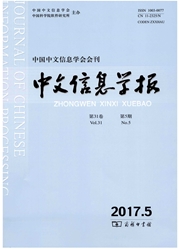

 中文摘要:
中文摘要:
把英汉人名音译问题转换为以音节为基本单位的翻译问题,将连续的音节组合看作短语,引入一种基于短语的统计机器翻译方法,实现英汉人名的音译。首先,针对现有音节划分方法存在的问题,提出一种改进的音节划分方法;其次,该文提出去除低频词法及基于C-value方法对短语表进行优化,解决了训练语料偏小导致短语表中出现杂质信息的问题;之后,融入了汉语人名中首字(词)及尾字(词)的位置特征,改善了生成的音译候选中汉字选取的不合理性;最后,提出了两阶段音节划分方法,缓解了音节划分粒度过大导致的音译错误。与基准方法相比,其音译准确率ACC由63.78%提高到67.56%。
 英文摘要:
英文摘要:
The English Chinese name transliteration can be described as syllable-based translation, which can be solved by current a phrase based statistical machine translation model. After describing a detailed rule-based syllab- ification method, this paper presents a translation phrase table optimization by frequency thresh hold and c-value. In addition, the method is also featured by integrating the local features of Chinese names, as well as a two stage of syl- labification strategy. The experimental results show that the performance of the English-Chinese name translitera tion is improved from 63. 78% to 67.56% in terms of ACC.
 同期刊论文项目
同期刊论文项目
 同项目期刊论文
同项目期刊论文
 期刊信息
期刊信息
